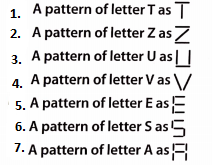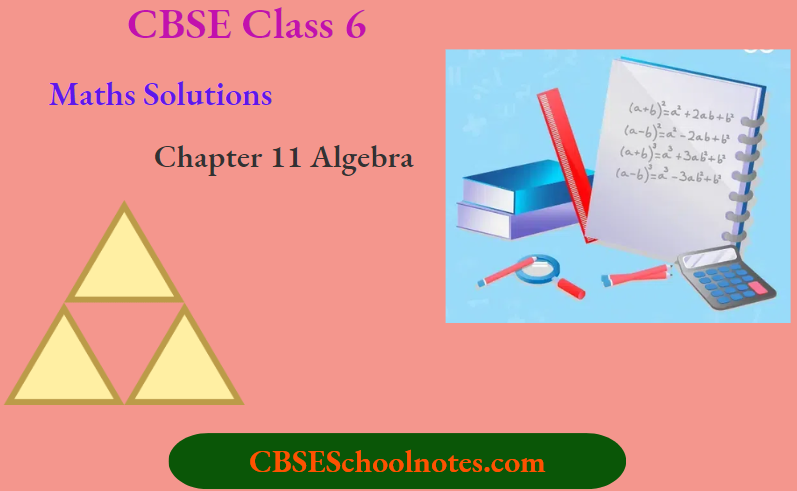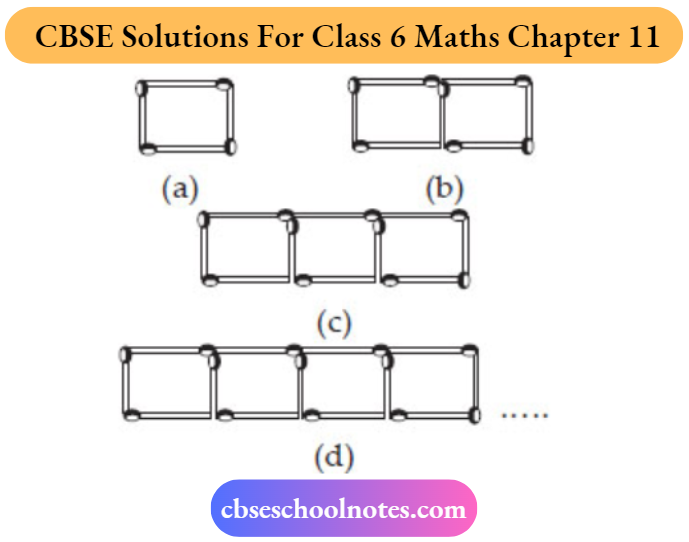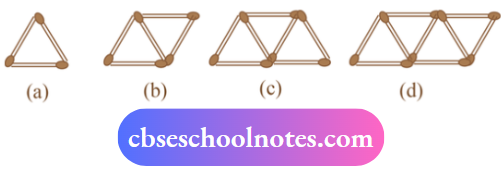Algebra Exercise – 11.1
Question 1. Find the rule which gives the number of matchsticks required to make the following matchstick patterns. Use a variable to write the rule.

Solution:
1. Number of matchsticks required to make one![]() =2
=2
∴ Number of matchsticks required to make a pattern of letter T as ![]() =2n
=2n
2. Number of matchsticks required to make one ![]() = 3
= 3
∴ Number of matchsticks required to make a pattern of letter Z as ![]() = 3n
= 3n
3. Number of matchsticks required to make one ![]() = 3
= 3
∴ The number of matchsticks required to make a pattern of the letter U is ![]() = 3n
= 3n
4. Number of matchsticks required to make one ![]() = 2
= 2
∴ Number of matchsticks required to make a pattern of letter V as ![]() = 2n
= 2n
5. Number of matchsticks required to make one ![]() = 5
= 5
∴ Number of matchsticks required to make a pattern of letter E as ![]() = 5n
= 5n
6. Number of matchsticks required to make one ![]() = 5
= 5
∴ The number of matchsticks required to make a pattern of the letter S is ![]() = 5n
= 5n
7. Number of matchsticks required to make one![]() = 6
= 6
∴ The number of matchsticks required to make a pattern of letter A is ![]() = 6n
= 6n
Question 2. We already know the rule for the pattern of letters L, C and F. Some of the letters from Q.1 (given above) give us the same rule as that given by L. Which are these? Why does this happen?
Solution:
Part (a) & (d) i.e., letters T and V have the same rule as that given by L. Because the number of matchsticks required in each of them is 2.
Question 3. Cadets are marching in a parade. There are 5 cadets in a row. What is the rule which gives the number of cadets, given the number of rows? (Use n for the number of rows.)
Solution:
Let the number of rows = n
Number of cadets in each row = 5
Therefore, the total number of cadets = 5n
Question 4. If there are 50 mangoes in a box, how will you write the total number of mangoes in terms of the number of boxes? (Use b for the number of boxes.)
Solution:
Let the number of boxes = b
Number of mangoes in each box = 50
Therefore, the total number of mangoes = 50b
Question 5. The teacher distributes 5 pencils per student. Can you tell how many pencils are needed, given the number of students? (Use s for the number of students.)
Solution:
Let the number of students = s
Number of pencils distributed to each Student = 5
Therefore, the total number of pencils needed = 5s
Question 6. A bird flies 1 kilometre in one minute. Can you express the distance covered by the bird in terms of its flying time in minutes? (Use t for flying time in minutes.)
Solution:
Let the flying time of the bird be two minutes.
Distance covered by the bird in minute =1 km
∴ Distance covered by the bird in t minutes =1 x t km = t km
Question 7. Radha is drawing a dot Rangoli (a beautiful pattern of lines joining dots) with chalk powder. She has 9 dots in a row. How many dots will her Rangoli have for r rows? How many dots are there if there are 8 rows? If there are 1 0 rows?
Solution:
The number of dots in each row = 9
Number of rows = r
Therefore, the total number of dots = 9r
When there are 8 rows, then the number of dots = 9 x 8 = 72
When there are 10 rows, then the number of dots = 9×10 = 90

Question 8. Leela is Radha’s younger sister. Leela is 4 years younger than Radha. Can you write Leela’s age in terms of Radha’s age? Take Radha’s age to be x years.
Solution:
Radha’s age = x years
Since Leela is 4 years younger than Radha.
Therefore, Leela’s age = (x- 4) years.
Question 9. Mother has made laddus. She gives some laddus to guests and family members; still, 5 laddus remain. If the number of laddus’s mother gave away is l, how many laddus did she make?
Solution:
Number of laddus gave away = l
Number of remaining laddus = 5
∴ Total number of laddus = (l + 5)
Question 10. Oranges are to be transferred from larger boxes into smaller boxes. When a large box is emptied, the oranges fill two smaller boxes, and 10 oranges remain outside. If the number of oranges in a small box is taken to be x, what is the number of oranges in the larger box?
Solution:
Number of oranges in a small box = x
Number of smaller boxes = 2
Therefore, the total number of oranges in smaller boxes = 2x
Number of remaining oranges = 10
Thus, the number of oranges in the larger box = 2x + 10
Question 11. 1. Look at the following matchstick pattern of squares. The squares are not separate. Two neighbouring squares have a common matchstick.
Observe the patterns and find the rule that gives the number of matchsticks in terms of the number of squares. (Hint: If you remove the vertical stick at the end, you will get a pattern ofCs.)

2. The given figure gives a matchstick pattern of triangles. As in Exercise 11 (a) above, find the general rule that shows the number of matchsticks in terms of the number of triangles.

Solution:

If we remove 1 matchstick from each figure, then they make multiples of 3, i.e., 3, 6, 9, 12, 8,
So the required equation = 3x + 1, where x is number of squares

If we remove 1 matchstick from each figure, then they make multiples of 2, i.e., 2, 4, 6,8…
So the required equation = 2x + 1, where x is several triangles.
